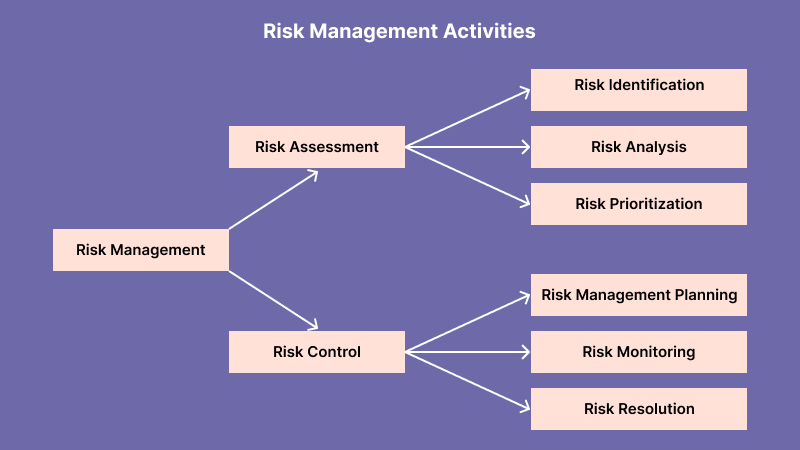Software Risk Analysis Tutorial: Comprehensive Guide With Best Practices
- Learning Hub
- Software Risk Analysis Tutorial: Comprehensive Guide With Best Practices
OVERVIEW
Software risk analysis is the process of analyzing and measuring software risks. During the analysis, it looks for code violations that threaten the stability, security, or performance of the code. The risk is measured using code analyzers that evaluate both the code and the interactions between units inside the application. Software risks arise primarily from these interactions.
In project management, risk analysis is a series of processes to identify risks that may harm the project’s success. The projects are differentiated into small, medium, and large, and each of them can be affected by risks.
On the other hand, the processes include identifying the type of risk, analyzing the risk, and managing and controlling the risk. If performed accurately, risk analysis can uncover potential severe problems that might affect the project. Risk analysis can be viewed as a proactive rather than a reactive approach, and it is essential to perform it at the beginning of the project.
What is software risk analysis?
Software risk analysis involves identifying risks in applications and prioritizing them for testing. Risk is the potential loss or damage to an organization caused by a materialized threat. The purpose of analyzing risks is to identify all the potential risks and then quantify their severity. If it occurs, it exploits a security vulnerability in the computer system. When developing a test strategy, consider the risks of testing your product and the likelihood of affecting your software.
Detecting risks at the production stage can be expensive. Hence, risk analysis during testing is ideal for understanding what goes wrong before entering production.
In addition, a risk analysis performed during the testing phase can identify flaws that could result in severe issues in the production process. By identifying possible software flaws, developers can find solutions to address them and reduce the overall risk.
Why perform software risk analysis?
It is common for software projects to involve implementing unique features and utilizing software technology advancements. As technology advances, so do the vulnerabilities of software systems. Therefore, software products are increasingly at risk of failure or under performance.
The risks involved in projects are caused by various factors, such as schedule delays, wrong cost estimates, a lack of resources, and security risks.
However, certain risks are inevitable. Some of them are as follows.
- The time you allocate for testing.
- In complex or large applications, flaw leaks can occur.
- An urgent need for the client to complete the project.
- The requirements are unsatisfactory.
So rather than keeping an eye on risk possibilities, it's crucial to identify, prioritize, and mitigate risk or take preventive measures proactively throughout the software development process.
Possible scenarios of risk occurrence
Software risks can occur from three possible scenarios.
- Unknown unknowns: These are technology-related risks entirely unknown to the organization. The risks generally arise from working with an unknown tool or technology.
- Known knowns: These risks are factual and well-known to the team. For instance, a lack of developers may cause a risk of delaying software development. These risks are identified early and documented in the project management plan.
- Known unknowns: The company is aware of the risks, yet they are unsure whether such risks exist in the project. For instance, a miscommunication between the client and the project team can result in capturing misinformation. Again, this is a known fact; however, whether the client has communicated the correct information is unknown to the team.
Types of software risk
Different tasks are carried out in software development based on the agile development framework. Building and maintaining software applications involves risk at each step. Therefore, risk identification is a critical step during the software development life cycle as it defines the success and failure of a software project.
Following the different types of risks in software development.
- Schedule risk: It refers to time-related or project delivery planning risks. These risks mainly occur when projects run behind schedule, resulting in the development not progressing on time and affecting the project's delivery. If schedule risks are not taken care of, it can lead to project failure and impact the organization's ROI.
- Budget risks: They are monetary risks resulting from budget overruns. In every project, the financial aspect has to be managed as per the project plan, but when the financial aspect is mismanaged, budget concerns arise, giving rise to budget risks. For a project to succeed, finance distribution and management should be appropriately managed.
- Operational risks: These refer to the procedural risks that occur in day-to-day operational operations throughout project development due to poor process implementation.
- Technical risks: These relate to the operational or performance risk, which indicates that this technical risk is mainly associated with the software application's functionality or performance.
- Programmatic risks: They are mainly inescapable or external risks and are beyond the control of programs.
Principles of risk management
Creating an effective risk management strategy will help protect your company's resources, reputation, and workforce. Each organization communicates risk uniquely, with its own internal culture and risk management policy.
When planning for risk, the risk management strategy should consider both the internal and external environment. A project manager can develop strategies to avoid, control, and overcome risk.
There are seven key risk management principles to consider when incorporating a risk management plan into your project.
- Identify risks early: Determine the source of potential risk and develop mitigation and response measures if it occurs. Once risk is identified and sourced, you can measure it.
- Organization’s goals and objectives: Ensure that your risk management strategy aligns with the overall aims and objectives of your organization.
- Context: When dealing with project risks, context is critical since each organization communicates risk differently and has its own internal culture and risk management procedures. While risk planning, the risk management strategy should consider both internal and external contexts.
- Include stakeholders: Involve stakeholders in decision-making throughout the risk management process. It will help you find and get insights into potential risks you might not have considered in your risk planning.
- Roles and responsibilities: One should implement the risk management plan transparently. Everyone should understand their role in risk mitigation, and responsibilities should be defined and included throughout the risk management process.
- Evaluate risk: Once you have identified the risks and made a risk management plan, evaluate risk at each step and implement any interventions or preventative measures if needed.
- Review: After completing a project, evaluate how your risk management plan worked and see if there is scope for further improvement. Always seek to improve how you handle risk and use those learnings in your next project.
Each organization will have various desired targets and priorities, which should be factored into the risk management strategy. The risk strategy should be in line with the organization's overall objectives and culture.
How to perform software risk analysis
To implement risk analysis in software testing, evaluate the source code in detail to understand its interaction with other components of an application. The evaluation is performed to address various code components and map their interactions.
By using the map, transactions can be detected and assessed. Structural and architectural rules are imposed on the map to identify and comprehend the essential software flaws.

After identifying the risks, the ones with the probability of becoming true and higher loss must be prioritized and controlled.
Risk assessment
The purpose of the risk assessment is to identify and prioritize the risks at the earliest stage and avoid losing time and money.
Under risk assessment, you will go through
- Risk identification: It is crucial to detect the type of risk as early as possible and address them. The risk types are classified into
- People risks: related to the people in the development team
- Tools risks: related to using tools and other software
- Estimation risks: related to estimates of the resources required to build the software
- Technology risks: are related to the usage of hardware or software technologies required to build the software
- Organizational risks: are related to the organizational environment where the software is being created.
- Risk analysis: Experienced developers analyze the identified risk based on their experience gained from previous projects. In the next phase, the project management team estimates the probability of the risk occurring and its seriousness
- Risk prioritization: The risk priority can be identified using the formula below p = r * s
Where,
p stands for priority
r stands for the probability of the risk becoming true or false
s stands for the severity of the risk.
After identifying the risks, the ones with the probability of becoming true and higher loss must be prioritized and controlled.
Risk control
Risk control is performed to manage the risks and obtain desired results. Once identified, the risks can be classified into the most and least harmful. Then, according to the type of risks, the project manager devises risk containment strategies based on their ingenuity.
Under risk control, you will go through:
- Risk management planning: You can leverage three main strategies to plan risk management.
- Reduce the risk: This method involves planning to reduce the loss caused by the risk. For instance, planning to hire new employees to replace employees serving notice.
- Transfer the risk: This method involves buying insurance or hiring a third-party organization to solve a challenging problem that might pose harmful risks
- Avoid the risk: This method involves implementing various strategies, such as incentivizing underpaid, hardworking engineers who might quit the organization
- Risk monitoring: It includes tracking and evaluating different levels of risk in the project team. After completing the risk monitoring process, the findings can be utilized to devise new strategies to update ineffective methods
- Risk resolution: It involves eliminating the overall risk or finding solutions. This method includes techniques such as design to cost approach, simulating the prototype, benchmarking, etc
Tools for software risk analysis
Software risk analysis tools can help your project management team identify and remove risk factors in a software project. Some of the most popular are listed below.
- LogicManager: LogicManager can help detect, evaluate, and mitigate risk issues. It includes a risk monitoring feature that assists in collecting and testing metrics. It also has other features like dashboards, graphical data visualization, and more.
- EHSInsight: It is a software risk analysis and management tool with cloud capabilities, a mobile application, key performance indicators, a dashboard, and reports. EHSInsight also offers tools like an incident management system, audit management system, root cause analysis, etc
- EcoOnline: Risk assessment software offers a task-based template for analyzing and managing risks. For efficient risk resolution, it assigns risks to relevant team members. In addition to a risk estimation calculator, the tool also offers graphs and charts to visualize data
Best practices for software risk analysis
Managing risk effectively is the most critical aspect of your software project's success. By following best practices for software risk analysis and management practices, your software development team should be able to eliminate most risk factors or, at the very least, control their effects.
- Employ a user-market-oriented development strategy.
- Use incremental software development methods such as Agile
- Invest in quality control activities
- Use a variety of estimation strategies along with automated estimation tools.
- Conduct design review meetings
- Before the software project begins, hire the best talents
- Invest in the training and development of software development teams.
- Manage client and customer relationships effectively
- Invest in software risk analysis and management techniques
Also, to save costs around your testing efforts, always choose cloud-based testing platforms to simplify things by giving your QA teams access to different browsers, devices, and platforms.
Setting up a local testing lab is extremely expensive and requires additional setup; therefore, continuous quality cloud like LambdaTest helps devs and testers by providing an online browser farm of 3000+ real browsers, devices, and OS combinations to perform manual and automation testing of web and mobile apps, thereby saving both operational and resource costs.
Subscribe to the LambdaTest YouTube Channel and stay updated with the latest tutorials around Selenium testing, Cypress testing, Playwright, and more.
Wrapping up
Risk analysis in software testing is one of the most effective methods to implement agile principles. It enables QA teams to appropriately position tests in a structure that best suits the software's needs. Customers and business owners benefit from this since risk-free software supports high-quality user experiences and profitable revenue streams.
Frequently Asked Questions (FAQs)
What are examples of software risks?
There are various internal and external risks in software development, like code issues, unsatisfied expectations, tight deadlines, etc.
How do you do a risk analysis in software?
To perform a risk analysis on software, evaluate the source code in detail to fully understand how it interacts with other components. Various code components are addressed in the evaluation, and their interactions are mapped. By using the map, one can detect and assess transactions. After that, structural and architectural rules are applied to the map to identify and understand the critical software flaws.
Author's Profile

Bhawana
Bhawana, marketer in profession and a tech enthusiast at heart, embarks on a continuous learning journey in the realm of software testing. Recently joining Lamdatest, her passion for QA and software testing is evident in her work. With a keen interest in mastering the intricacies of testing methodologies, Bhawana is dedicated to honing her skills and achieving excellence in the ever-evolving tech landscape.
Reviewer's Profile

Shahzeb Hoda
Shahzeb currently holds the position of Senior Product Marketing Manager at LambdaTest and brings a wealth of experience spanning over a decade in Quality Engineering, Security, and E-Learning domains. Over the course of his 3-year tenure at LambdaTest, he actively contributes to the review process of blogs, learning hubs, and product updates. With a Master's degree (M.Tech) in Computer Science and a seasoned expert in the technology domain, he possesses extensive knowledge spanning diverse areas of web development and software testing, including automation testing, DevOps, continuous testing, and beyond.
Try LambdaTest Now !!
Get 100 minutes of automation test minutes FREE!!

 Christmas Deal is on: Save 25% off on select annual plans for 1st year.
Christmas Deal is on: Save 25% off on select annual plans for 1st year.


